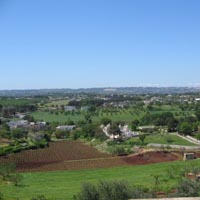
The Valle d'Itria between smells, tastes, landscapes in the company of those who live in this area
 The Valle d'Itria between smells, tastes, landscapes in the company of those who live in this area.
The Valle d'Itria between smells, tastes, landscapes in the company of those who live in this area.
Look around, walking slowly, savoring the culture of Apulia.
Getting lost in ancient architecture of white Trulli and stone walls, surrounded by the intense green color of vegetation and sharp rocks of the Apulian Murgia , the writer Tommaso Fiore, said, "... you would ask me how many people have been able to dig and shape these stones .... Only the hard work of a population of ants could succeed in "
A route that, through the voices and gestures of those who live in this area, will lead us to explore the Valle d'Itria: walking along the ancient sheep- tracks of transhumance in the company of donkeys, tasting wines rich in fruit and herbal essences, kneading durum wheat flour and listening to the rhythmic sounds of tambourine.
The theme of this travel in Apulia can be described in a word that has a lot to do with the culture of Apulia and little with our lifestyle: the "slowness ".
A guided tour by local associations that help farmers and local communities to guard jealously the stories and traditions of this wonderful corner of Apulia.
| Partecipants: | 4 -8 people |
|---|---|
| Length: | 1 week |
| Route: | Starting point: Masseria Santanna First leg: with donkeys in search of sheep- tracks and then between the Trulli of Alberobello. Second leg:At the Natural Reserve of Torre Guaceto to discover the deliciousness of the green gold of Apuglia, the extra virgin olive oil. Third leg: a route in bike or in the farm for a relaxing massage and then the tour of Ostuni. Fourth leg: A tour of Castellana Grotte and then in the farm with the Apulian producers who will reveal the secrets to make a very good home-made Pasta and Mozzarella cheese. Fifth leg: A tour of Pianelle Forest and Martina Franca Sixth leg: A tour of Locorotondo, tasting the delicious local wines |
BEAUTIES TO BE DISCOVERED |
The Valle d’Itria and its small villages
The Valle d’Itria is bounded by the territories of Martina Franca, Alberobello and Cisternino. They are natural balconies which allow to admire a landscape characterized by strips of oak woods and Mediterranean vegetation. "Valle" is an inaccurate term because this area is karstic and constituted by hills and valleys dotted with old buildings called Trulli and white farms.
The name of "Valle d'Itria" probably comes from the oriental cult of the monks worshipping Madonna of Odegitria (or Santa Maria d'Itria or d’Idria) considered the protector of travellers, who founded in the valley a monastic site where was found a fresco depicting the Madonna Odegitria.
The natural and marine reserve of Torre Guaceto is the coastline of the Salento peninsula situated in front of the towns of Brindisi and Carovigno on the Adriatic Sea. It is dominated by the stately tower from which the area takes its name. The coast forms a sandy bay closed by three small islands and characterized by a bed of Posidonia. Here it is possible to find the Caretta Caretta sea turtles together with numerous species of fishes which breed in this area.
Bosco delle Pianelle is a natural regional reserve which has an historical importance because of its nearness to a vital road system that connected this region to the main centers of the Italic culture: the Apennine Mountains, the Via Appia and the Via Trajana which linked up the Ionian to the Adriatic coast.
The sheep-tracks and the transhumance
Each year, the shepherds led millions of sheep from Abruzzo to Apulia. This migration needed wide grass streets that could provide nourishment to the cattle during the long journey that lasted an average of 3 weeks. Thus the sheep-tracks were at the same time streets and pastures, places of settlement for factories, churches, taverns, and villages.
Grill-rooms
Local people tell several stories about the emergence of these unusual places to eat. Some argue that in the past they were used for the preparation of meat by the butchers of the Murgia only during the feasts of the patron saints .
Others argue that they were born because, in the past, the farmers were paid by the day and, coming home, they stopped in the butcher’s to buy meat with the money earned during the day.
The butchers then became hosts giving life to one of the first experiments of Apulian street food: they cooked the meat in ovens placed inside the butcher’s to feed men who passed through these places.
Most grill-rooms are very simple: the tables covered with paper tablecloths are in the back of the butcher’s. In summer it is possible to dinner in the streets of the villages.
The first sep is to choose the meat which will be barbecued; then, awaiting for it, it is possible to taste a variety of salami and cold pork meats, cheese, pickles, olives and taralli biscuits (coiled pastry – biscuits).


